Charm Bracelet 10th Anniversary Celebration
Come celebrate the ten-year anniversary of the Charm Bracelet trail system!
[MORE]
|
WHS Teacher Receives WCLT’s Pepper Award
The Ellie and Jack Pepper Award recognizes a community member who has done outstanding work in conservation and land preservation.
[MORE]
|
Annie Reid Receives WCLT’s President’s Award
The President’s Award recognizes a WCLT member who has given exemplary service to the organization.
[MORE]
|
From the Outreach Committee:
Speaking of Conservation . . . Part 2
Have you ever wondered about the best ways to talk about conservation to friends, neighbors, or people you don’t know?
[MORE]
|
Backyard Wildlife
A Home in the Grill
Nan has a mouse family in her grill!
[MORE]
|
Meet the President
John Metzger Elected WCLT President
John Metzger was elected president of the Westborough Community Land Trust at the annual meeting in June.
[MORE]
|
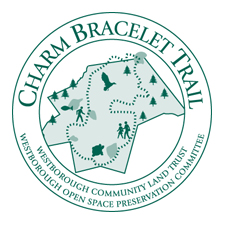
Come out to celebrate the ten years that Westborough residents have enjoyed the Charm Bracelet trail system on Sunday,
September 26 from 1:00 to 3:00 pm at the Mill Pond School grounds. Gather friends and family, bring your own picnic, socialize,
and walk nearby trails. Cider and cookies will be available, and WCLT members will lead walks.
Check out the new color WCLT trail maps of the area, available to download and print out from the
WCLT web site. See especially the trail maps for:
The Charm Bracelet trail system has grown dramatically over the past decade, thanks to the work of many dedicated volunteers.
It now includes 21 miles of main trails and 24 miles of side trails.
The main Charm Bracelet trail passes near Mill Pond School as it traverses 10 miles across the south side of Westborough.
This stretch goes from Minuteman Park at Sandra Pond to the MBTA commuter rail station on Smith Parkway, linking “charms”—open
space areas in town—as it was intended to do.
 Ten years ago this fall, Don Burn, who has been the force behind the creation and building of the Charm Bracelet, led an
inaugural walk along the first section of the Charm Bracelet, starting at Minuteman Park. That first section is now part of the
10-mile stretch across the south side of town.
Ten years ago this fall, Don Burn, who has been the force behind the creation and building of the Charm Bracelet, led an
inaugural walk along the first section of the Charm Bracelet, starting at Minuteman Park. That first section is now part of the
10-mile stretch across the south side of town.
Today, if you walk that south side Charm Bracelet trail, you will encounter these “charms” along the way:
- The Town’s Minuteman Park at Sandra Pond (off Upton Road)
- Bowman Conservation Area, the Town’s first conservation area
(see trail map)
- WCLT’s Hidden Meadow, the destination of the Charm Bracelet’s inaugural walk in October 2000
(see trail map)
- WCLT’s Upper Jackstraw Brook Reservation, including Gilmore Pond
(see trail map)
- The Town’s Libbey Conservation Area
(see trail map)
- Wile Forest, owned by the New England Forestry Foundation
(NEFF)
- Headwaters Conservation Area, the Town’s second conservation area
(see trail map)
- The Town’s Veterans Freedom Park, formerly the Lee property
- The south and north shores of Mill Pond
(see trail map)
- The Town’s historic Hoccomocco Pond
Among the many other portions of Charm Bracelet trail that Westborough residents can enjoy today is a long 7.5-mile stretch
that crosses the north side of town. It goes between Mass Fish and Wildlife headquarters and the Sudbury Valley Trustees’ Sawink
Farm.
When all sections are eventually linked together, the Charm Bracelet trail will make a grand 28-mile loop around Westborough,
with an extensive network of side trails connecting neighborhoods to the loop. WCLT is working to secure three easements and one
state agreement for this purpose.
The Charm Bracelet project is the brainchild of Don Burn, long-time chair of WCLT’s stewardship committee. It is a joint
effort of the Town’s Open Space Preservation Committee (OSPC) and the private, nonprofit Westborough Community Land Trust
(WCLT). In 2008, WCLT presented Don with a special award recognizing his many contributions to the organization and to Westborough.
Back to top
|
|
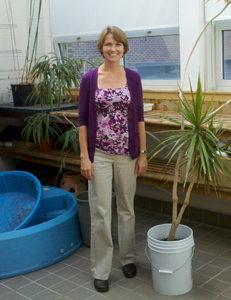
Anita Lotti
Westborough High School (WHS) environmental science teacher Anita Lotti received the Westborough Community Land Trust’s 2010
Ellie and Jack Pepper Award at the Annual Meeting in June. The Pepper Award recognizes a community member who has done outstanding
work in conservation and land preservation.
“We commend Anita Lotti for her role in creating the next generation of the environmentalists,” said outgoing WCLT
president Garry Kessler when he presented the award. He noted that Ms. Lotti (as she is known to her students) involved her
environmental science students, as well as environmental club members, in WCLT’s purple loosestrife biocontrol project.
What do the high school students get out of taking part in the project? Ms. Lotti explains that the project gives them a chance
to apply concepts learned in class—biodiversity, ecology, and invasive species—to real life in a hands-on way. The students
also gain real experience in collecting and analyzing field study data, and they get a sense of what it might be like to work as an
environmental scientist.
“The project is also part of their service learning,” Ms. Lotti notes. “They’re learning to take care of
their own community—to give back to their community.”
Ms. Lotti and WCLT began working together in fall 2008 to plan the participation of her environmental sciences classes in
WCLT’s purple loosestrife biocontrol project. For the past two years, in spring of 2009 and 2010, the class dug up and potted
purple loosestrife plants, grew them in a simple simulated wetland in the WHS greenhouse, introduced starter beetles to the plants, and
raised a new generation of loosestrife-eating Galerucella beetles. Each summer, WCLT volunteers released the beetles in local
wetlands where invasive purple loosestrife has been taking over. Each fall, the class collects data at the release sites to
monitor the results of the project.
Ms. Lotti recently took the initiative to apply for and receive a grant from the Westborough Education Foundation to better
outfit and supply her class for its environmental work. She looks forward to purchasing hip boots to make it easier for students
to wade in wetlands while digging loosestrife plants and collecting data about loosestrife, cattails, and other vegetation.
Ms. Lotti has taught chemistry and environmental science at Westborough High School for six years. Before that, she worked in
the biotech industry for 15 years.
She lives in Holliston with her husband, who is an environmental engineer, and their three children—a son aged 13 and
daughters aged 10 and 8. “The environment is a big topic at our house,” she says.
She grew up in Winchester, MA and spent plenty of time outdoors as a child. She and her husband met while hiking.
Ms. Lotti holds a bachelor’s degree in biochemistry from the University of Massachusetts, but she became interested in
environmental science when she earned a master’s degree in toxicology from Northeastern University. “Toxicology combines
it all—chemistry, physiology, and environmental science,” she says.
Back to top
|
|
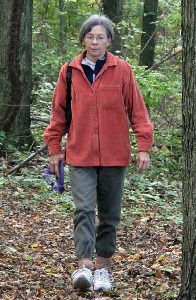
Annie Reid
At the Westborough Community Land Trust’s Annual Meeting in June, new WCLT president John Metzger presented the WCLT 2010
President’s Award to Annie Reid for her contributions to nature education and environmental preservation. He noted that the
President’s Award recognizes a WCLT member who has given exemplary service to the organization.
This is Annie’s seventh year of writing WCLT’s “Nature Notes” for the Westborough News, including more than 140 articles
about wildflowers, fungi, reptiles, insects, amphibians, mammals, and birds found in Westborough. Over the years,
“Nature Notes” has built up a wide audience.
“Knowing about the nature around you is like knowing your neighbors,” she says. “It helps you feel comfortable where you live
and gives you a keen sense of place.”
Writing about the discoveries found in forests and fields comes naturally for Annie. Growing up in Ridgefield, CT, she discovered
the natural world with her mother, brother, and Danish grandparents.
Early in life, Annie also found she enjoyed working with words. After graduating from Brown University where she studied
literature, she held various editorial positions at Houghton Mifflin Company in Boston. For the last 20 years she has worked as a
freelance editor on numerous college textbooks.
Annie “came back to nature” as an adult, when she and her husband, Garry Kessler, moved to Westborough in 1978 and had
two daughters. She became intrigued with wildflowers, especially after a family trip to the national parks out west. “We had a great
time identifying the park wildflowers,” she explains. “We were sad when the trip was over, but then I realized we could do the very
same thing right here in Westborough.”
When Garry started photographing wildflowers, husband and wife teamed up to create a
website showcasing the wildflowers at Bowman Conservation Area.
In 2004, they began collaborating on WCLT’s “Nature Notes.”
“Garry takes the photos and I write about the plants, birds, and other animals we see in Westborough,” says Annie. “It’s a
wonderful excuse to learn a lot about plants and animals and pull the information together in an article to share with others.”
Annie also edits WCLT’s newsletters and annual report. She serves as a naturalist on the WCLT Education Committee and chairs the
WCLT Scholarship Committee.
Annie’s most recent effort for WCLT involves working to protect the local environment by controlling purple loosestrife.
This invasive alien plant has been taking over local wetlands and choking out native plants.
WCLT’s purple loosestrife biocontrol project was inspired by a newspaper article about a high school teacher in Uxbridge who
worked with his classes to raise and release Galerucella beetles to control purple loosestrife. These beetles eat only
purple loosestrife and spend their entire life cycle on loosestrife.
After obtaining the necessary permissions for a similar project in Westborough, in 2009 Annie joined with Anita Lotti,
environmental science teacher and environmental club advisor at Westborough High School, to begin the project, which is planned to
continue through 2012.
Back to top
|
|
By Elaine Birkholz
If you love the outdoors, you probably share your enthusiasm for hiking, photography, bird-watching, or relaxing by a lake with
your family, friends, and neighbors. Maybe you’ve even thought about trying to persuade them to join you in supporting organizations
like WCLT, to protect our access to these natural resources. But what are the most effective things to say—or not say—to
accomplish that?
Last spring in this newsletter, we covered the results of a fascinating survey conducted in September 2009 by The Nature
Conservancy that included recommendations for making an effective case for conservation. These recommendations were based on
extensive research and a national survey of American voter focus groups. They included a list of words and phrases to which the
majority of focus group members responded positively.
Now we’d like to share with you the words and phrases to which the majority of focus group members responded negatively.
If you want to convince others of the importance of preserving open space:
- DO NOT point to more parks as a way to solve childhood obesity—focus group respondents do not think a lack of access to
outdoor recreation is the problem.
- DO NOT ask people to protect wildlife for wildlife’s sake only—most people want to know how they themselves will benefit
from habitat conservation.
- DO NOT focus on the importance of preserving “ecosystems”—people visit forests, wetlands, rivers, and mountains; they don’t
really care about “ecosystems.”
- DO NOT talk about preserving “biodiversity,” either—people don’t really know what that means.
- DO NOT make access to parks or public lands the centerpiece of appeals for conservation—only dedicated outdoor enthusiasts
recognize the need to create connections to other protected lands.
- DO NOT make global warming/climate change the primary rationale for conservation—these were the most politically polarizing
messages tested by the research team.
- DO NOT count on public support for conservation unless you work to make it happen yourself.
According to the survey, the most persuasive arguments focus instead on the recreational value of land; protecting land, water,
and wildlife for future generations; and on our sense of shared responsibility for preserving natural resources. Now those are
ideas we can all buy into!
Back to top
|
|
By Nan Burke
Grilling is in my blood. My father taught me the virtues of year-round cooking on the grill with his prized CharmGlow hooked
directly to the gas line. While I use propane, I’m out there in all sorts of weather to grill when the desire strikes.
Keep this in mind as I let you in on this secret, a secret that I’m only keeping from my two Maine Coons. (They are working
cats—a breed sailors prized for keeping mice out of their stores.)
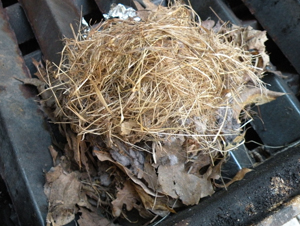
I have a mouse family in my grill! I went out March 8 to fire up the Weber for a steak dinner and found I had a panic-stricken
mouse in there. It had the rudiments of a nest where my foil-wrapped mesquite packet had been, and the nest included bits of aluminum
foil. I hurriedly removed the top grill, “flavorizer bars”, and even slid out the bottom section before I was able to
get the mouse to leave the grill. Then I removed a small cache of acorns along with the nest, reassembled things, and fired it up.
We had a nice steak dinner, fortunately NOT “à la mouse”.
Several days later (before the great deluge), I checked the grill and the mouse was still sans a house. Hopefully it was going to
stay gone, I thought. Maybe it would have second thoughts about camping somewhere that could get to 450 mesquite-smoking degrees or
so in just a few minutes.
We had the four days and four nights of steady rain, and then as the sun and hints of spring returned, on March 18th I came out
to grill some rainbow trout I’d rescued from the freezer. I opened the lid and found myself being stared down by the mouse,
which now had a luxurious fur and aluminum-lined bird’s nest made of mouse-mulched oak leaves. This mouse seemed not to be
freaked out by my presence. But why? It couldn’t be just because it had obviously spent a stormy week investing in building
a cozy nest in a very well protected and dry place.
The mouse reared up a little and gave me an imploring look. I immediately understood it then. The mouse was a mother with
newborns suckling at her teats. Chastened, I lowered the lid, and went in to the kitchen to pan-fry the trout. It would not have
tasted very good if I knew I’d destroyed her family’s home.
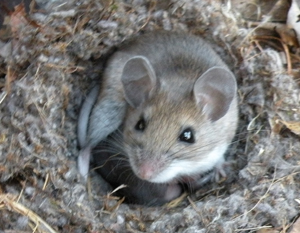
The next day, I looked in again, this time armed with a camera. She let me raise the grill bars a bit for a better view, and
I snapped a shot. I softly said, “Thank you, Lady.” and lowered the grill, then the lid.
I believe the mice are white footed mice, a mouse common to this area, especially on wooded lots such as ours. The mothers have
their first litter of the year in early spring, and are often pregnant before the current litter is weaned. A surviving female of
this litter may possibly have her first litter this summer, and live for about 18 months if she avoids the predators looking for
her. It takes several weeks for the newborns to grow fur, open their eyes, and be weaned. Then Mom kicks them out if she isn’t
pregnant with the next litter.
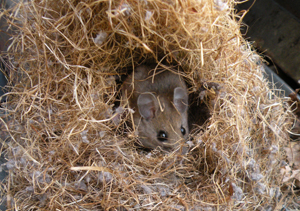
A week later, I checked in on the Weber family after a cold spell, and found that the mice had topped off their nest. I removed
the top of the nest to see how far along the pups were, and found they were large, but were lightly furred and still blind. The
mother bolted the nest, suckling pups still attached. I replaced the top of the nest, but not the grill bars, and closed the lid.
On May 3, I decided the mice should be ready for their relocation, since I was tired of dealing with a charcoal grill. When I
opened the lid, the mice fled the nest. They looked grown enough to be on their own and they were over six weeks old. I removed
the entire nest, made sure the mice were out of the grill, and fired it up. Now I check the grill carefully before starting it.
Sometimes, I have to chase out a mouse who wants to check out the old homestead.
Now it is Fall. It is common for mice to get into the house to winter as it gets colder. The unlucky ones get to meet the
unsympathetic Maine Coons.
Back to top
|
|
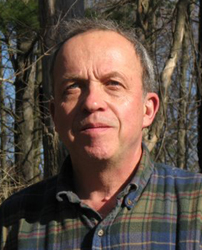
John Metzger
John Metzger was elected president of the Westborough Community Land Trust at the annual meeting in June.
Previously, John served two years as vice president (2008–2010) and a year as acting chairman of the stewardship
committee. He has been a director since 2006.
John is a native of Buffalo, NY, and gained an early appreciation for the outdoors along the shores of Lake Erie and on fishing
trips to northern Ontario.
John studied physics at Princeton University and then computer science at the University of Toronto. He and his wife Kathie
moved to Westborough in 1975 to join the booming computer industry here. He has worked for three decades in the local high tech
industry.
“The longer I’ve lived in Westborough, the more I’ve come to value the open space opportunities close at
hand,” John says.
John has also been active in the Westborough Community Chorus and Sudbury Valley Trustees (SVT). In 2008 he was featured in the
Volunteer Spotlight in SVT’s newsletter, The Wren, for his work as property steward and bluebird monitor at SVT’s
Walkup-Robinson Reservation in Westborough, where he also worked on projects with Boy Scout Troop 100.
John admits to periodic infatuations with hiking, canoeing, and sailing. He is a decades-long gardener of modest accomplishment.
Lately he has developed an interest in wildflowers for their ability to thrive without his ministrations.
Contact information for John Metzger:
jmetzger@netezza.com, 508-366-1724
Back to top
|
|
|